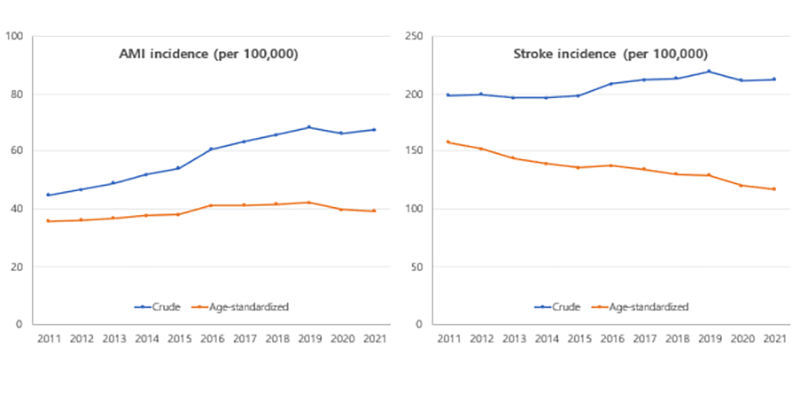Incidence, Fatality, and Mortality Trends of CVD in Korea

Hyeon Chang Kim, MD, PhD
Yonsei University, Korea
Cardiovascular diseases (CVD) are the leading cause of global mortality, with acute myocardial infarction (AMI) and stroke being particularly severe conditions. While the number of deaths from AMI and stroke is monitored through vital statistics, national statistics on the incidence and fatality rates have not been adequately tracked. To address this issue, the Korea Disease Control and Prevention Agency (KDCA) recently designated the National CVD Statistics Production Center to conduct an in-depth analysis of National Health Insurance Big Data, thereby calculating the incidence of AMI and stroke. This has led to the establishment of a system that allows for the monitoring of incidence, fatality, and mortality rates of AMI and stroke in Korea.
The crude incidence rate of AMI per 100,000 person-years consistently increased from 44.7 in 2011 to 68.3 in 2019, before slightly declining to 67.4 in 2021. The age-standardized incidence rate of AMI showed a 19% rise from 2011 to 2019, followed by a slight decline in 2020 and 2021. This increasing trend in AMI incidence was more pronounced in males than in females. Both 30-day and 1-year case fatality rates remained stable, with a minor surge in case fatality observed in 2021. The crude mortality rate for AMI remained steady at around 20 cases per 100,000 person-years from 2011 to 2021, but the age-standardized mortality rate decreased continuously, with an overall reduction of about 37% during the same period.
The crude incidence rate of stroke hovered around 200 cases per 100,000 person-years from 2011 to 2015, then surged to 219.3 in 2019, before slightly declining to 212.2 in 2021. In contrast, the age-standardized incidence rate consistently decreased by 26% between 2011 and 2021. Case fatality rates for stroke consistently decreased from 2011 to 2019 but began to increase in 2020 and 2021. The crude mortality rate for stroke decreased from 32.3 per 100,000 person-years in 2011 to 27.9 in 2019, but then increased to 33.2 in 2021. The previously declining age-standardized mortality rate for stroke also increased in 2021, suggesting that the impact of COVID-19 may require further investigation.
The consistent rise in AMI incidence rate and the number of cases over the past decade, along with the increase in stroke mortality after a period of decline, underscores the urgent need for ongoing surveillance, targeted interventions, and advanced research to effectively combat CVD in Korea.

Figure 1. Incidence rate of acute myocardial infarction and stroke in Korea, 2011-2021
